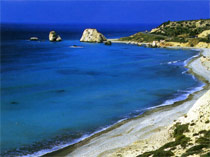Pafos
(Paphos) - Playground of the Gods
Capital
of the West and positively teeming with history is Pafos,
site of the island's second international airport. The resort
town has as its focal point a charming fishing harbour by
Pafos Fort, lined with open-air cafes and tavernas that serve
a tempting menu of the day's catch.
It was on Pafos shoreline that the mythological Goddess
Aphrodite was born a legend that spawned a massive wave of
cult worship from neighbouring countries that lasted several
centuries. The large rock that juts from th sea is known as
"Petra tou Romiou"- The venus Rock- while the Baths
of Aphrodite at Polis also echoes her apparent penchant for
the island. At Palepafos, Kouklia lie the remains of the
Goddess earliest Sanctuary.
Another "first" for Pafos was its early recognition
of Christianity. While under Roman rule in 45 A.D., it was
here that Saint Paul converted the first ruler to the faith.

The legacy from its remarkable history adds up to nothing less
than an open museum, so much so that UNESCO simply added the
whole town to its World Cultural Heritage List. Among the
treasures unearthed, are the remarkable mosaics in the House
of Dionysos, Theseus ans Aion, beautifully preserved after
16 centuries under the soil. Then there are the musterious
vaults and caves, The Tombs of the Kings, the Pillar to which
Saint Paul was allegedly tied and whipped, the ancient Odeon
Theatre and other places of interest including the Byzantine
Museum and the District Archaelogical Museum.
Geroskipou with its remarkable five-domed Byzantine church of Agia
Paraskevi, and its Folk Art Museum is a village known for
many years for its special delight
"loukoumi".
Agios Neofytos Monastery, famous for its 'Encleistra',
Enclosure, carved out of the mountain by the hermit himself,
boasts some of the finest Byzantine frescoes of the 12th and
the 15th centuries. Chrysorrogiatissa Monastery makes its own
range of wines using homegrown grapes. A small museum
dedicated to Archibishop Makarios, is found at Pano Panagia.
From here it is a rewarding drive to the majestic Cedar Valley.
home of the indigenous Cyprus horned sheep, the moufflon.
Lempa village can be singled out as one with particylar
historic significance. In its pretty setting near the sea,
Lempa's link with prehistory is the site of a chalcolithic
settlement. today the faithful reconstruction of several
dwellings, gives an insight into chalcolithic life on the
island.
Further north lies the resort-town of polis, overlooking the
beautiful Chrysochou Bay with its charming fishing refuge of
Latsi. The relatively unspoilt state of the countryside and
villages make the area a real delight for the walker and
naturalist.
The low-lying scenery around Pafos, much of it cultivated with
banana plantations and backed by the gentle foothills of the
western Troodos range, has an attractively open quality to it.
This is the gateway to the Penisula of Akamas, a natural
wilderness of incredible beauty with breathtaking gorges,
spectacular coastlines and enjoyable
nature
trails
















